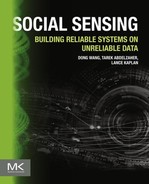Foreword
Technology has impacted all our lives. Whether it is technological advances in medicine, transportation, manufacturing, agriculture, defense, entertainment or just about any area whatsoever, there is sometimes a resulting major change in how we live, work, and socialize. The Internet is a prime example of this phenomenon. Today, combining the Internet capabilities with the proliferation of sensors is producing a new revolution, called social sensing. This book is at the forefront of this emerging set of capabilities.
At the center of this new area is the concept of real-time, person centric broadcasting. An important characteristic of social sensing is the ability for an individual to have connectivity to information while he is on the move. TV and radio stations are a small number of information sources that broadcast to the masses. With social sensing each person can become both a broadcaster and consumer of information in almost any location. This fundamentally changes how we exchange information. However, important questions must be resolved for this paradigm to become useful. The major issues are reliability, trustworthiness, coverage, security, privacy, and real-time availability of the data being broadcast by individuals.
Fortunately, this book makes major progress at resolving many of these issues. For example, many individuals may report on a situation such as a major traffic accident, by tweeting, taking pictures, and recording sounds in the area of the situation. Is the sensor data reliable? Perhaps the microphone has a poor quality sensor which fails to record key information sounds. Are the pictures taken trustworthy? Perhaps a person fakes the photo. Is there enough information to obtain a complete picture of the incident and current state of the accident? How soon will the information be available to interested parties? This book begins to develop theoretical foundations for social sensing analytics that tackles many of these issues. It does this by combining machine learning, information fusion, data mining, and statistics to support reliability and trustworthiness.
One major value of this book is the comprehensive review of the analytical theories and frameworks underlying this area. Another is the lucid way that confidence is addressed for social sensing. The book also uniquely describes participatory and opportunistic sensing, together with social data scavenging, and demonstrates how these social sensing trends contribute to social sensing.
While research results in this area of social sensing have been accelerating, the literature is disjoint and often fails to take a comprehensive view. The book is remarkable in that it synthesizes the concepts and fundamentals found in the research and goes much beyond a summary by putting forth new and exciting solutions and directions.
It is also important and instructive to place social sensing in the larger context of wireless sensor networks (WSN) and cyber physical systems (CPS). To date most WSNs and CPSs collect information from physical sensors. These sensors may be noisy, in error, or even unavailable at times (e.g., devices go into sleep mode to save energy). Many techniques(e.g., Kalman filters) have been developed to deal with these stochastic situations. With social sensing there is now the ability to provide a potentially large number of sensing streams based on human provided inputs. What is the equivalent set of techniques to attain confidence in the sensing results? This book gives analytic results that explain how to attain guarantees in these social sensing scenarios. With this capability it seems that our next generation WSNs and CPSs can be improved by social sensing.
Over the years there have been many results and studies involving humans-in-the-loop. For example, the most common situation is supervisory control. In supervisory control, involvement of humans takes place in two ways. In one case, the process runs autonomously. Humans intervene with the control algorithm when it is necessary, typically by adjusting set points. These control problems are well understood. In the other case, the process accepts a command, carries out the command autonomously, reports the results and waits for further commands to be received from the human. As a concrete example, human-in-the-loop control is used in a wheelchair-mounted robotic arm to retrieve an object from a shelf. In this feedback control system, human provides input via a touch screen or joystick which is analyzed by a vision processing system to position the robotic arm to retrieve the object. In these cases the human is the controller. The human has also been the system. Here physiological properties (blood pressure, lung volume, heart rate) of a human are monitored and controlled by some device or drug. Social sensing now focuses on the human being a sensor. This potentially supports the creation of many new applications and capabilities, especially in the WSN, CPS, and Internet of Everything (IOE) systems.
Many research communities can play a role in advancing the social sensing field, including, WSN, CPS, IOE, signal processing, machine learning, data mining, and natural language processing. While many of these related areas are obvious contributors, the book adds important clarifications that articulate the distinctions between sensing and data mining, and how natural language processing solutions are needed.
In summary, this is an exciting book; the first of its kind. It addresses a new and emerging field of social sensing in a comprehensive and analytical manner. You will enjoy reading it!
